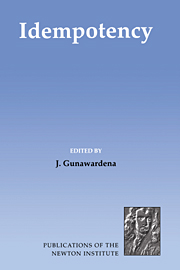Book contents
- Frontmatter
- Contents
- Foreword
- Preface
- List of Participants
- An introduction to idempotency
- Tropical semirings
- Some automata-theoretic aspects of min-max-plus semirings
- The finite power property for rational sets of a free group
- The topological approach to the limitedness problem on distance automata
- Types and dynamics in partially additive categories
- Task resource models and (max, +) automata
- Algebraic system analysis of timed Petri nets
- Ergodic theorems for stochastic operators and discrete event networks.
- Computational issues in recursive stochastic systems
- Periodic points of nonexpansive maps
- A system-theoretic approach for discrete-event control of manufacturing systems
- Idempotent structures in the supervisory control of discrete event systems
- Maxpolynomials and discrete-event dynamic systems
- The Stochastic HJB equation and WKB method
- The Lagrange problem from the point of view of idempotent analysis
- A new differential equation for the dynamics of the Pareto sets
- Duality between probability and optimization
- Maslov optimization theory: topological aspect
- Random particle methods in (max, +) optimization problems
- The geometry of finite dimensional pseudomodules
- A general linear max-plus solution technique
- Axiomatics of thermodynamics and idempotent analysis
- The correspondence principle for idempotent calculus and some computer applications
Periodic points of nonexpansive maps
Published online by Cambridge University Press: 05 May 2010
- Frontmatter
- Contents
- Foreword
- Preface
- List of Participants
- An introduction to idempotency
- Tropical semirings
- Some automata-theoretic aspects of min-max-plus semirings
- The finite power property for rational sets of a free group
- The topological approach to the limitedness problem on distance automata
- Types and dynamics in partially additive categories
- Task resource models and (max, +) automata
- Algebraic system analysis of timed Petri nets
- Ergodic theorems for stochastic operators and discrete event networks.
- Computational issues in recursive stochastic systems
- Periodic points of nonexpansive maps
- A system-theoretic approach for discrete-event control of manufacturing systems
- Idempotent structures in the supervisory control of discrete event systems
- Maxpolynomials and discrete-event dynamic systems
- The Stochastic HJB equation and WKB method
- The Lagrange problem from the point of view of idempotent analysis
- A new differential equation for the dynamics of the Pareto sets
- Duality between probability and optimization
- Maslov optimization theory: topological aspect
- Random particle methods in (max, +) optimization problems
- The geometry of finite dimensional pseudomodules
- A general linear max-plus solution technique
- Axiomatics of thermodynamics and idempotent analysis
- The correspondence principle for idempotent calculus and some computer applications
Summary
Introduction
If M is a topological space and f : M → M is a continuous map, it is frequently of interest to understand, for x ∈ M, the behaviour of iterates fk(x) as k approaches infinity. In this generality little can be said; but if f is “nonexpansive with respect to a metric ρ on M”, i.e. if ρ(f(x), f ≤ ρ(x, y) for all x, y ∈ M, then a variety of useful theorems, some of recent vintage, can be brought into play. Surprisingly, this simple and powerful observation has often been missed in studying specific classes of nonlinear operators.
In this note we shall state some theorems about nonexpansive maps, describe some conjectures and open questions, and indicate some specific classes of maps for which these observations prove useful.
Examples of Maps of Interest
We begin by recalling some terminology and basic facts. Let S denote a compact Hausdorff space, C(S) = X, the Banach space of continuous functions on S in the sup norm ∥x∥∞ = sup{|x(s) s ∈ S}, K the cone of nonnegative functions on S and K the interior of S. If S is the set of integers i with 1 ≤ i ≤ n, we identify C(S) with Rn in the obvious way and write K:= Kn, so Kn:= {x ∈ Rn|xi ≥ 0 for 1 ≤ i ≤ n}. We shall denote by u ∈ C(S) the constant map defined by u(s) = 1 for all s ∈ S. If S = {i ∈ Z| 1 ≤ i ≤ n}, we have u ∈ Rn and ui= 1 for 1 ≤ i ≤ n.
- Type
- Chapter
- Information
- Idempotency , pp. 231 - 241Publisher: Cambridge University PressPrint publication year: 1998

